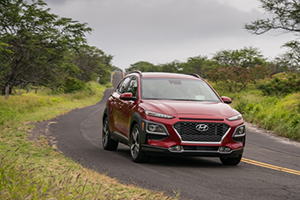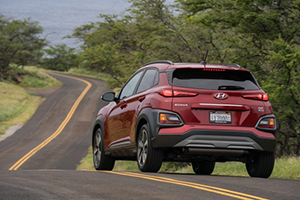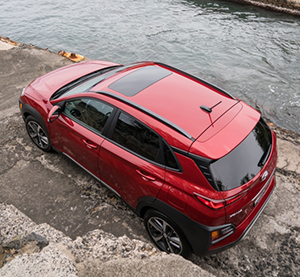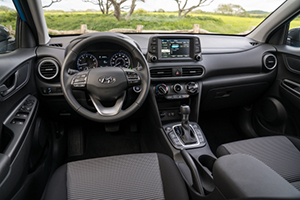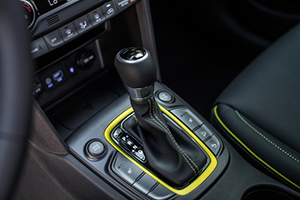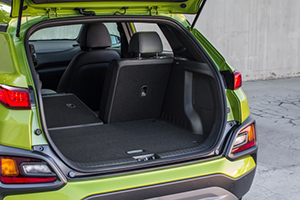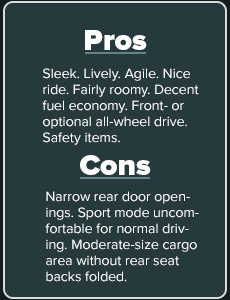2018 Hyundai Kona
The 2018 Hyundai Kona
crossover combines sportiness with utility
Prices: $19,500-$28,700
The 2018 Hyundai Kona is nicely suited to the booming crossover market.
Combine sexy styling, practicality and lively performance and a choice
of front-or optional all-wheel-drive and you’ve got the Kona.
The four-door hatchback compact Kona has aggressive body styling with a
low, wide stance, long wheelbase and short overhangs that make city
parking easier. Its low front end has Hyundai’s cascading
grille with a sporty mesh pattern that’s flanked by wing-like
fenders. Contrasting black “armor” visually
connects the front to the rear and doesn’t come off looking
overdone.
My test Kona really stood out with its Pulse Red paint and black roof.
You can get a Kona in a variety of colors, including Ultra Black, Sonic
Silver and Surf Blue. The roof is finished with an optional
color-contrasting color scheme, proving high contrast between the body
and wheels for a distinctive look.
The Kona costs approximately $19,500 to $28,700 and comes in Limited,
SE, SEL and Ultimate trim levels. The Kona is offered with
front- or optional all-wheel drive, but isn’t suited for
rough off-road use. Rather, it’s a good road machine, with a
supple suspension that soaks up bumps and has enough comfortable room
for four adults. However, a 6-footer with long legs behind a driver
doesn’t have much leg room to spare. And rear door openings
are rather narrow.
Large exterior/interior door handles assist sliding and out, and
occupants sit high. The optional all-wheel-drive system and drivetrain
is packaged to offer a roomy interior despite the Kona’s
compact exterior dimensions. However, although a driver sits
high, the hood slopes so sharply that he must be careful to avoid the
low front end from hitting such objects as solid parking area
barriers.
The trunk is fairly large, and the 60/40 split folding rear seat backs
are easily flipped down to greatly enlarge the cargo area. The rear
hatch raises smoothly on twin hydraulic struts, although my test
Kona’s hatch sometimes was reluctant to immediately go up
because it didn’t respond immediately to the key
fob’s command.
Powering the Kona is a 2-liter four-cylinder engine with 147 horsepower
and 132 pound-feet or torque or a turbocharged 1.6-liter motor with 175
horsepower and 195 lb.-ft. of torque. My test Kona had the non-turbo
engine, which mildly droned under hard acceleration. It works with a
smooth 6-speed automatic transmission with a manual-shift mode. The
turbo engine is coupled to a 7-speed dual-clutch automatic and is
offered for Limited and Ultimate trim levels.
The 2-liter engine provided lively in-town performance and decent 65-75
m.p.h. passing on highways. Estimated fuel economy was 27 city, 33
highway. Kona economy ranges from 28 in the city to 33 on highways,
depending on the engine/transmission combination.
I drove the $21,300 front-drive Kona SEL with the 6-speed automatic,
which can be put in Normal or Sport mode. The latter manages driving
dynamics by adjusting the steering effort and engine and transmission
control logic for enhanced driving performance. Normal mode is best for
most driving because the Sport mode causes excessive revs during
regular driving and makes the steering rather heavy.
The Kona has an all-new platform. The supple suspension easily soaks up
bumps, and the motor-driven power steering is responsive. Stable
handling is helped by electronic stability control and
traction control systems. The four-wheel disc brakes with downhill
brake control and hill-start assist control work with an
easily modulated pedal.
My test car’s quiet interior was upscale, with such things as
attractive checkered upholstery. There was a good amount of plastic
used but it had a nice pebble surface. There also was a pushbutton
start and easily reached controls for the power windows and the large,
heated outside mirrors. Air conditioning and Android Auto &
Apple CarPlay capability were standard. The 7-inch color touchscreen
was easy to use, and the dashboard had handy auxiliary controls. All
doors had large storage pockets, and the console cupholders were placed
to help avoid spills.
The manual front seats provided unusually good support and the
wide-range tilt/telescopic steering wheel will help a variety of
different-sized drivers get more comfortable. Available for
Kona’s are a power driver’s seat, leather heated
seats, automate air conditioning and a heads-up display.
Safety feature highlights include side curtain air bags with rollover
sensors. There’s also blind-spot collision warning with
lane-change assist, rear cross-traffic collision warning, forward
collision-avoidance assist with pedestrian detection and driver
attention warning.
Fluid filler areas are easily reached once the extra-heavy hood is held
open with a prop rod. Struts would make it less of a muscle builder
unless you want to leave the checks to a mechanic.
Hyundai calls the Kona an “active lifestyle”
vehicle, and thus it’s fittingly named after the west coast
region of Hawaii’s big island.
